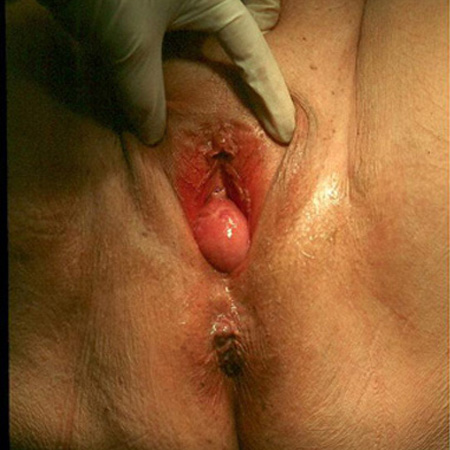Criteria
Pelvic organ prolapse quantification (POP-Q) examination[32][33][34]
The POP-Q examination measures nine points on the vagina and perineum relative to the hymen: six internal points and three external points. Stages are based on the maximal extent of prolapse relative to the hymen, in one or more compartments:
Stage 0: no prolapse
Stage I: the most distal prolapse is >1 cm above the level of the hymen
Stage II: the most distal prolapse is between 1 cm above and 1 cm below the hymen (i.e., at the hymen)
Stage III: the most distal prolapse is >1 cm below the hymen but no further than 2 cm less than the total vaginal length. [Figure caption and citation for the preceding image starts]: Apical prolapse POPQ stage IIIFrom the personal collection of Prof L. Brubaker and Dr L. Lowenstein; used with permission [Citation ends].

Stage IV: represents procidentia/total prolapse. [Figure caption and citation for the preceding image starts]: Total uterovaginal prolapse (procidentia) POPQ stage IVFrom the collection of Prof L. Brubaker and Dr L. Lowenstein; used with permission [Citation ends].

Baden–Walker halfway scoring system[35]
In the Baden–Walker system, the vagina is divided into six areas: two anterior, two superior, and two posterior. Each area of the vagina is assigned a grade from 0 to 4, according to the degree of descent relative to the hymen when the patient is straining maximally:
Grade 0: normal position for each respective site
Grade 1: descent halfway to the hymen
Grade 2: descent to the hymen
Grade 3: descent halfway past the hymen
Grade 4: maximum possible descent for each site.
The Baden–Walker system is no longer commonly used because it is imprecise and not reproducible.
Use of this content is subject to our disclaimer